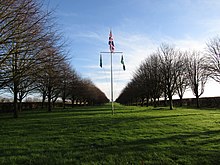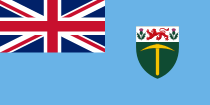Flag of Southern Rhodesia
The flag of Southern Rhodesia was a
Construction

The flag of Southern Rhodesia consisted of a blue ensign with the Union Jack in canton. The coat of arms was designed to be symbolic of Southern Rhodesia. The lion and thistles came from the coat of arms of Cecil Rhodes, the founder of Southern Rhodesia, and the yellow pick on a green background symbolised mining and farming.[1]
History
Southern Rhodesia
The flag of Southern Rhodesia was adopted in 1924 by the

In 1956, Southern Rhodesia entered into a
Rhodesia
Following the collapse of the federation in 1964, Southern Rhodesia then started calling itself Rhodesia and adopted a new flag at the behest of the
Despite Smith's claim, some Rhodesians felt that the flag implied that Rhodesia was still a colony and not an independent nation.
After UDI
Owing to Rhodesia's UDI not being recognised officially internationally, whenever Rhodesia appeared on the international stage, the new flag was not used. In 1972, the
In 1979, Southern Rhodesia was restored under the direct control of a British governor following the Lancaster House Agreement. Despite the restoration of the colony, the Union Jack was treated as the only official flag of Southern Rhodesia for this time, though the flag of Zimbabwe Rhodesia was also used as a de facto flag.[14] When Lord Soames arrived to become Governor of Southern Rhodesia, the Zimbabwe Rhodesia flag was flying at the airport and not the Union Jack. When asked why, the Rhodesian airport officials stated "We can fly whatever flag we like".[14] The flag of Southern Rhodesia was not used again; it was the Union Jack rather than the Southern Rhodesian flag that was lowered when Britain granted independence to Zimbabwe in April 1980.[15]
See also
References
- ISBN 0822518252.
- ISBN 0719038731.
- ^ ISBN 978-1869191122.
- ISBN 0903274000.
- ^ "Southern Rhodesia gets flag". New York Times. 8 April 1964. Retrieved 29 March 2017.
- ^ a b Smith, Whitney, ed. (1976). The Flag Bulletin. Volumes 15–17. Winchester, Massachusetts: Flag Research Center. p. 46.
- ISBN 978-1466934085.
- ISBN 0299131238.
- ^ a b c d Kenrick, David (2 July 2015). "These Colours Don't Run: Choosing the Rhodesian Flag". Academia.edu. Retrieved 20 July 2016.[permanent dead link]
- ^ Smith, L.G. (1974). The statute law of Rhodesia: made on or before the 31st August, 1974, Volume 1. Salisbury: Government Printer. p. 91.
- ^ "Union Jack lowered for the last time in independent Rhodesia". Montreal Gazette. 11 November 1968. Retrieved 20 July 2016.
- ^ "ON THIS DAY 1972: Rhodesia out of Olympics". BBC News. 22 August 1978. Retrieved 20 July 2016.
- ^ "Olympics: Rhodesia expelled". Montreal Gazette. 23 August 1972. Retrieved 20 July 2016.
- ^ ISSN 0720-0471.
- ^ "High Independence Hopes Vanish for Most Zimbabweans". Voazimbabwe.com. 18 April 2016. Retrieved 20 July 2016.

